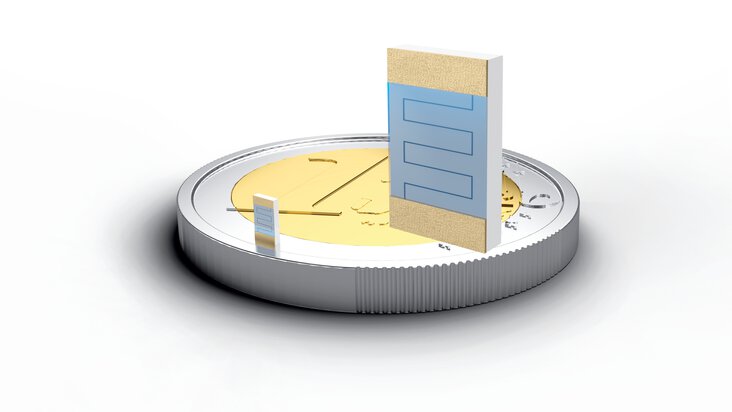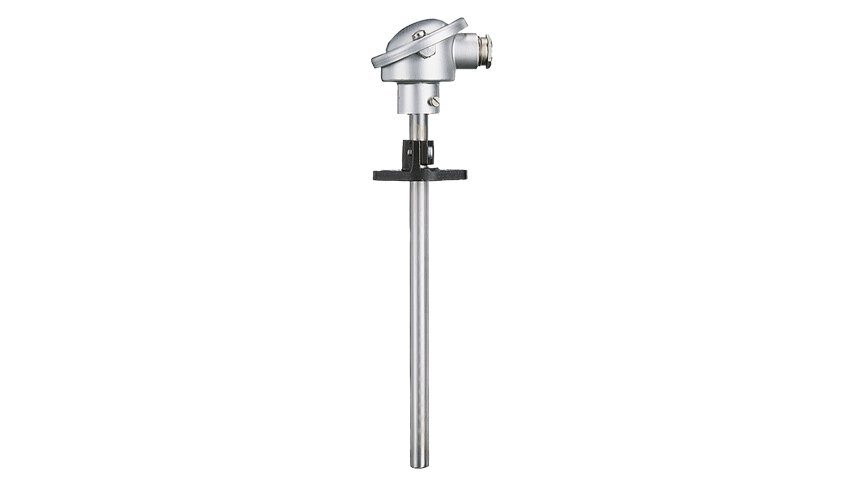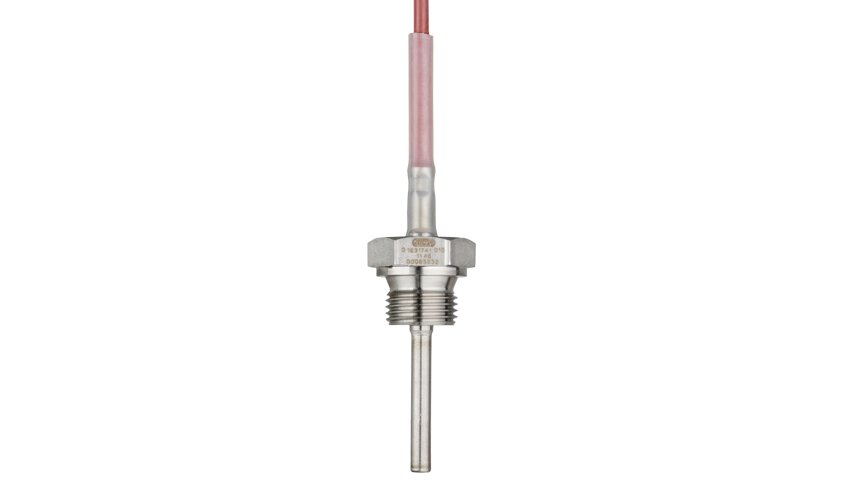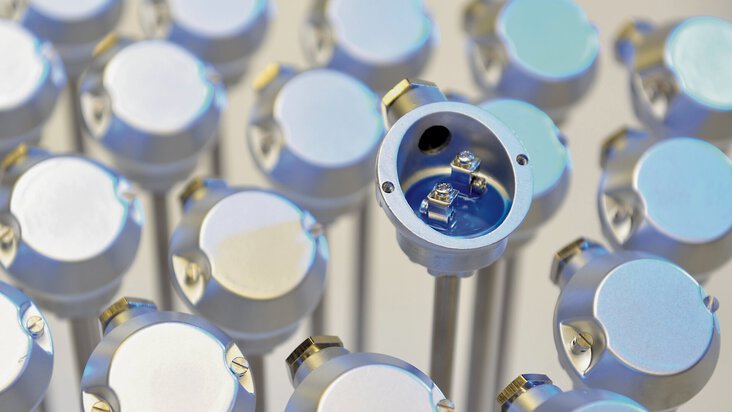
热电阻温度探头
有许多不同的热电阻温度探头。最常见的是带终端头的热电阻温度探头或带连接电缆的热电阻温度探头。 带接线头的热电阻温度探头有一个模块化设计。它由测量插件、热电偶套管、接线头和其内部的连接插座以及可能的法兰或压缩配件组成。只有热电阻温度探头的那一部分被指定为温度传感器,它被安装在直接受被测变量影响的地方。 对于带连接电缆的热电阻温度探头,不需要测量插件和接线头。温度传感器直接连接到连接电缆上,并插入热电偶套管中。为了消除应力,热电偶套管的末端被多次卷起或压入(保护等级IP65)。热室和温度传感器之间的空间通常用导热材料填充,以改善与被测介质的热接触。最高测量温度主要由连接电缆的护套和绝缘材料的温度电阻决定。
Table of content
What is an RTD?
RTD stands for the term "Resistant Temperature Detector" and refers to a temperature sensor that makes use of the interaction of ohmic resistance and temperature. Therefore, the sensor is also referred to as a resistance thermometer. Depending on the application, RTDs are available with different resistance elements.
Which sensors are installed in RTDs?
Platinum chip temperature sensors are generally used in RTDs. From the user's point of view, platinum offers the great advantage of being very stable over the long term. A Pt100 sensor is usually used. The designation "Pt" stands for platinum and the number "100" for 100 Ω base resistance at 0 °C. The resistance of the Pt100 increases by about 0.38 Ω per Kelvin temperature increase. Pt1000 temperature sensors are also used in industrial applications. Here, the electrical characteristics are ten times greater (base resistance 1000 Ω and temperature coefficient about 3.8 Ω/ Kelvin).

Pt100 sensor as part of a resistance thermometer
How do resistance thermometers work?
A change in temperature has a direct effect on the electrical resistance of a metallic conductor and thus enables conclusions to be drawn about the temperature. The temperature coefficient or temperature coefficient of the platinum sensors (approx. 0.38 %/Kelvin) is based on the physical properties of platinum; the basic resistances result from specifications. The characteristic curve is fixed in the standard DIN EN 60751, so that the application of the RTDs is relatively simple. The RTD is connected to an evaluation unit and the field device determines the ohmic resistance. Usually, linearizations such as Pt100 and Pt1000 are available in the field devices, after which the device determines the sensor temperature from the ohmic resistance. For more information on the design and function of resistance thermometers, watch the video.
电阻温度计是如何构造的?
有许多不同的热电阻温度探头。最常见的是带终端头的热电阻温度探头或带连接电缆的热电阻温度探头。
带接线头的热电阻温度探头有一个模块化设计。它由测量插件、热电偶套管、接线头和其内部的连接插座以及可能的法兰或压缩配件组成。只有热电阻温度探头的那一部分被指定为温度传感器,它被安装在直接受被测变量影响的地方。
对于带连接电缆的热电阻温度探头,不需要测量插件和接线头。温度传感器直接连接到连接电缆上,并插入热电偶套管中。为了消除应力,热电偶套管的末端被多次卷起或压入(保护等级IP65)。热室和温度传感器之间的空间通常用导热材料填充,以改善与被测介质的热接触。最高测量温度主要由连接电缆的护套和绝缘材料的温度电阻决定。
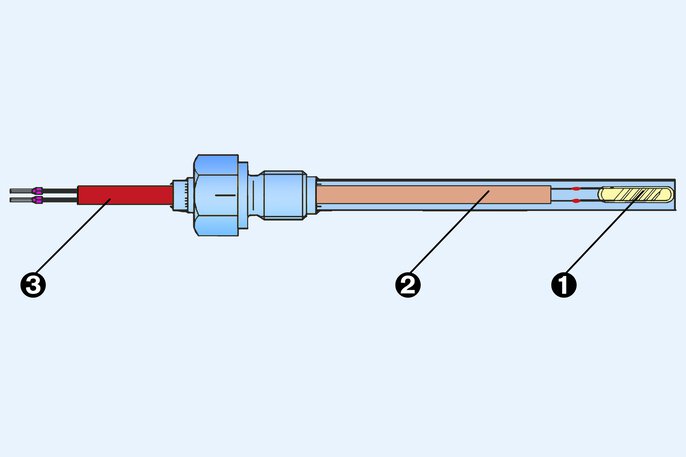
Structure of an RTD: 1 = sensor, 2 = inner line, 3 = connection line
Insertion thermometer with connection head
The connection head contains a connection socket for attaching the connection cable. The thermometer is fixed by a flange. Thermometers of this type allow measurement of up to 600 °C and are frequently used in furnace construction.
Screw-in thermometer with connection cable
Screw-in thermometers allow the pressure-tight termination of the process. In the case of thermometers with connecting cable, the maximum temperature is limited by the cable. Maximum temperatures of about 400 °C can be measured.
Surface probe
Surface probes have the advantage that they do not require a process connection. They measure the temperature of a surface and thus allow conclusions to be drawn about the medium temperature in a pipe system or tank. However, precision measurements are not possible with them.
Thermometer with connection plug
In order to allow easy mounting/dismounting of screw-in thermometers, it is often useful to obtain them with a connector plug. The connection systems shown below are frequently used.

Machine connector M12 × 1 4-pole according to IEC 60947-5-2
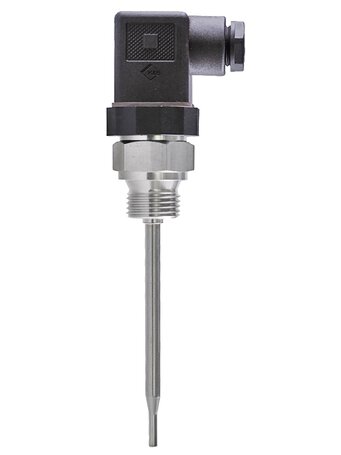
Connector according to DIN EN 175301
什么是测量插件?
测量插件是由温度传感器和连接底座组成的现成单元,温度传感器被放置在一个直径为6或8毫米的插入管中,该管由SnBz6制成,符合DIN 17 681标准(最高温度为300℃)或镍。它被插入实际的保护管中,保护管通常由不锈钢制成。
电阻温度计如何连接?
热电阻温度探头的电阻随温度的变化而变化。为了检测输出信号,要测量由恒定测量电流引起的电压降。
有3种连接类型:两线制、三线制和四线制。
在两线制技术中,评估电子装置和温度传感器用两线制电缆连接。对于三线制技术,一条额外的电缆被引向热电阻温度探头的一个触点。这样就形成了两个测量电路,其中一个被用作参考。四线制技术为热电阻温度探头提供了最理想的连接可能性。测量结果不受导线电阻或其随温度变化的影响。

Field device with two-wire connection
Three-wire connection
With the three-wire connection, an additional wire connects the resistance sensor to the evaluation unit. The evaluation unit measures the voltage drop at the resistance sensor and the connecting leads (UM). With the help of the third conductor, the evaluation unit further determines the voltage drop at one conductor (UL½ ). The double amount of this voltage is subtracted from UM and thus the voltage drop at the resistance sensor is determined. If all wires have the same resistance, no error results from the line resistances and the resistance of the sensor is determined without error. The three-wire connection is sufficient for most applications.

Field device with three-wire connection
Four-wire connection
The fourth wire is used to determine the exact voltage at the resistance sensor in the four-wire connection.

Field device with four-wire connection
In this way, the resistance value is always determined accurately - even if the wire or terminal resistances are different. It is used for high accuracy requirements such as in reference or resistance thermometers in the laboratory field.
为什么两线制技术会出现不正确的测量值?
像任何其他电导体一样,温度探针和评估电子装置之间的线路有一个电阻,与温度传感器串联在一起。这意味着这两个电阻相加,导致温度读数系统地升高。在更远的距离上,线路电阻可能达到几欧姆,并导致测量值的相当大的虚化。为了避免上述两线制技术的问题,并且仍然能够省去多线制电缆,使用了两线制发射器。发射器将传感器信号转换为4 ... 20mA的标准化温度线性电流信号。发送器也通过两根连接电缆供电,使用4mA的静态电流。由于零点的提高,这也被称为 "生命零点"。两线制发射器还有一个优点,就是通过放大信号,大大降低了对干扰的敏感性。对于发射器的放置,有两种设计。由于未放大信号的距离应尽可能短,以减少信号的易受干扰性,因此可以直接安装在温度计的连接头中。然而,这种最佳解决方案有时与设计条件相矛盾,或者在发生故障时,发射器可能难以到达。在这种情况下,就会使用开关柜中的轨道安装的变送器。然而,更好的接入的优势是由未放大的信号必须覆盖更长的距离所换来的。
三线技术中的第三条线有什么好处?
在三线制电路中,引线电阻的大小和温度相关性都可以得到补偿。然而,所有三个磁芯的先决条件是相同的属性和相同的温度,它们被暴露在其中。由于这在大多数情况下都有足够的精度,所以三线技术是目前最常见的。线路补偿是没有必要的。
- ${title}${badge}

